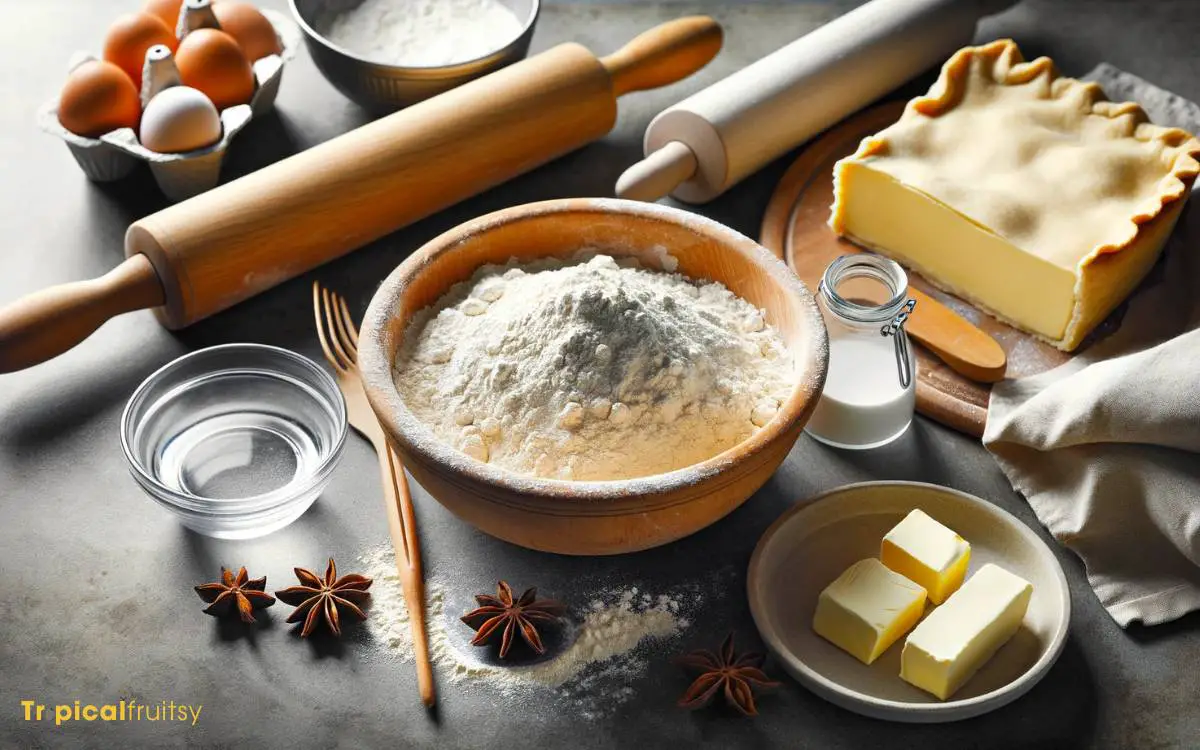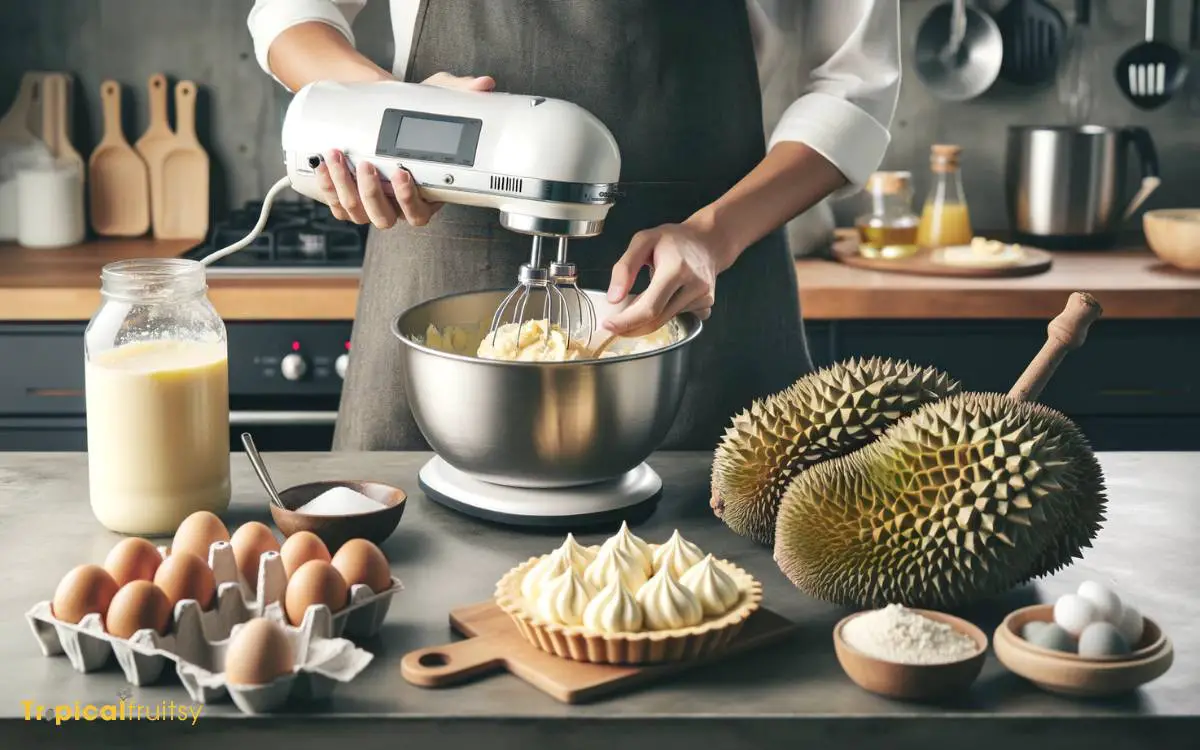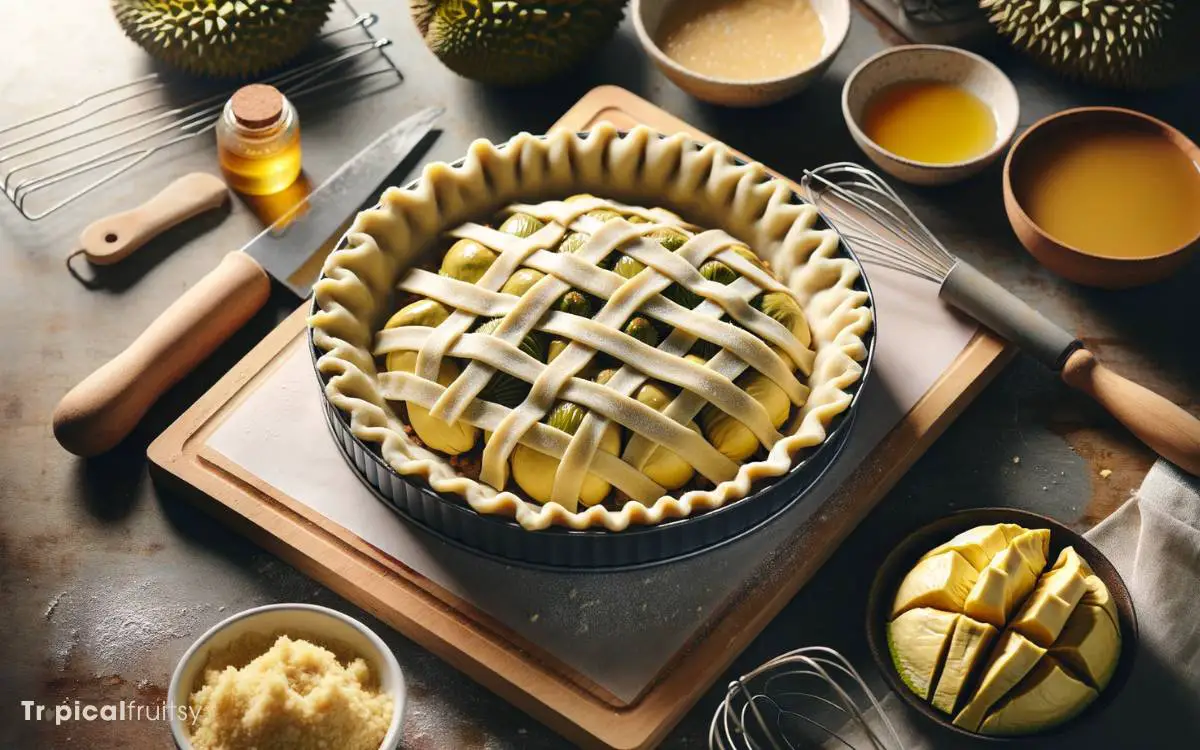How to Make Durian Pie? 5 Easy Steps!
Creating a durian pie perfectly blends the strong aroma and taste of durian with the classic, indulgent feel of pie.
Start by selecting a high-quality, ripe durian to ensure the filling is flavorful. The crust should be a golden, buttery pastry, providing an ideal base for the filling.
The filling is made by combining durian pulp with cream, sugar, and spices, creating a smooth and creamy consistency.
Follow this step-by-step guide to prepare, assemble, and bake a durian pie that will delight the senses with its unique flavor profile.
Here are some quick steps:
For example, using a combination of cinnamon and nutmeg can enhance the flavor of the durian filling.
Indulge in the exotic flavors of durian pie, a dessert that offers a unique twist on a beloved classic.

Key Takeaway
Step 1: Selecting the Perfect Durian

Before embarking on the preparation of your durian pie, it is essential to select a durian fruit that is ripe and of high quality to ensure the best flavor and texture for your dessert.
A premium durian exudes a distinctive aroma, potent yet not overwhelming, which serves as an initial indicator of its ripeness.
Gently press the husk; a mature durian will yield slightly under pressure, suggesting the presence of soft, creamy flesh within. The stem of the fruit should appear moderately dry, signifying optimal harvest time.
Furthermore, a high-quality durian should have a relatively firm husk free of blemishes and cracks, as these could indicate internal spoilage.
Examine the lobes; well-formed, plump lobes promise an abundance of flavor-packed pulp, quintessential for a luscious, indulgent durian pie.
Step 2: Preparing the Pie Crust

Having selected a ripe durian, the next step in crafting a delectable durian pie is to prepare the pie crust, which will serve as the foundation for your filling.
The crust’s texture and flavor are pivotal, offering a contrast to the creamy richness of the durian. Precision in this stage ensures a pie crust that is both flaky and able to contain the luscious filling without becoming soggy.
Consider these essential facets:
- Chill the Dough: Prevents butter from melting, maintaining a flaky texture.
- Even Thickness: Promotes uniform cooking and textural consistency.
- Docking the Base: Prevents puffing during baking.
- Pre-baking: Also known as ‘blind baking’, solidifies the crust, guarding against sogginess.
With the pie crust meticulously prepared and pre-baked, we shall now venture into the heart of the pie-making process: making the durian filling.
Step 3: Making the Durian Filling

With the pie crust now ready, the next crucial step is to prepare the durian filling, which will imbue the pie with its distinctive flavor and creamy texture.
Begin by selecting ripe durian fruit; its flesh should yield to gentle pressure, indicating a soft, custard-like consistency ideal for pie filling.
Carefully remove the large seeds and puree the flesh until smooth, using a food processor or blender. The resulting puree should be homogeneous and free from fibrous strands.
For enhanced richness, blend the durian puree with a custard base made from a mixture of heavy cream, sugar, and eggs that have been tempered and cooked to a velvety consistency.
Ensure uniform integration by gently folding the custard into the puree, taking care not to deflate the mixture, preserving the airy quality that will contribute to the filling’s luxurious mouthfeel.
Step 4: Assembling the Pie

Preheat the oven to 375°F (190°C) as the first step in assembling the durian pie to ensure it is at the correct temperature for baking.
With the oven coming to temperature, begin by rolling out your chilled pie dough on a floured surface to fit a 9-inch pie dish.
Gently place the dough into the dish, pressing it into the corners and up the sides while trimming any excess overhang.
Consider the following when layering the durian filling:
- Spread the durian filling evenly to prevent air pockets, which can cause the crust to warp.
- Ensure the edges of the crust are sealed to contain the filling, using a bit of water if necessary.
- Crimp the edges decoratively, providing a barrier to the filling and an artisanal touch.
- If a top crust is desired, carefully place the second rolled-out dough over the filling, pressing the edges to seal.
Once assembled, bake according to your recipe’s instructions until the crust is a golden brown, and the aroma of cooked durian fills the kitchen.
Step 5: Baking and Serving Tips

Upon placing the durian pie in the oven, monitor the baking process to ensure the crust achieves a perfect golden hue without burning.
The key to a delectable crust lies in its color, a rich, amber tone that signifies a flaky texture and buttery flavor.
Employ a pie shield or aluminum foil around the edges to protect them from over-browning while the bottom crust cooks evenly.
To ascertain the pie’s readiness, observe the filling; it should exhibit a slight jiggle, indicating a custard-like consistency that will set upon cooling. Once baked, let the pie rest at room temperature for a minimum of two hours.
This patience rewards you with slices that hold their shape, presenting the durian’s creamy indulgence with structural integrity for a truly sophisticated dessert experience.
Conclusion
In the alchemy of baking, the durian pie stands as a symbol of bold culinary exploration. Its golden crust encases a rich, creamy core that challenges the palate with complex flavors.
This delicacy is a harmonious blend of traditional technique and exotic ingredient, satisfying the quest for novel tastes.
Moreover, the durian pie represents a bridge between cultures. Each slice serves as a testament to the adventurous spirit inherent in the art of gastronomy.







Focuses on implementing measures to protect players , including safeguarding vulnerable individuals and promoting safe habits .
Establishing limits for time spent helps avoid excessive losses, while tools like self-exclusion options empower informed decisions .
Training staff ensures timely intervention of problematic behavior , fostering a accountable gaming culture.
mostbet casino
Providing access such as counseling services and educational materials enables users to manage habits effectively.
Following guidelines like age verification and transparency in odds builds trust within the industry .
Aim to build a balanced ecosystem where enjoyment coexists with emotional well-being, ensuring long-term engagement .